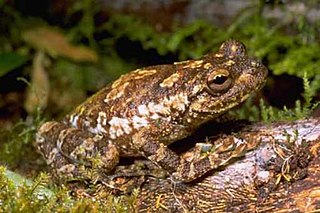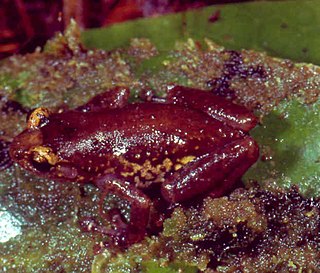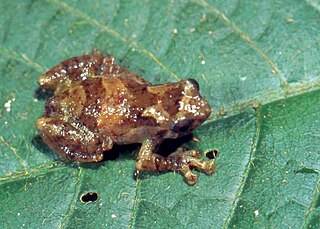
The conservation status of a group of organisms indicates whether the group still exists and how likely the group is to become extinct in the near future. Many factors are taken into account when assessing conservation status: not simply the number of individuals remaining, but the overall increase or decrease in the population over time, breeding success rates, and known threats. Various systems of conservation status are in use at international, multi-country, national and local levels, as well as for consumer use such as sustainable seafood advisory lists and certification. The two international systems are by the International Union for Conservation of Nature (IUCN) and The Convention on International Trade in Endangered Species of Wild Fauna and Flora (CITES).

Villa's gray shrew is a shrew native to northeastern Mexico, where it is called musaraña.
Cophyla phyllodactyla is a species of frog in the family Microhylidae. It is endemic to Madagascar. Its natural habitats are subtropical or tropical moist lowland forests, subtropical or tropical moist montane forests, plantations, rural gardens, and heavily degraded former forest. It is threatened by habitat loss.
Platypelis alticola is a species of frog in the family Microhylidae. It is endemic to Madagascar. Its natural habitat is subtropical or tropical moist montane forests. It is threatened by habitat loss.

Platypelis barbouri is a species of frog in the family Microhylidae. It is endemic to Madagascar. Its natural habitats are subtropical or tropical moist lowland forests, subtropical or tropical moist montane forests, and heavily degraded former forest. It is threatened by habitat loss.
Platypelis cowanii is a species of frog in the family Microhylidae. It is endemic to Madagascar. Its natural habitat is subtropical or tropical moist montane forests.

Platypelis grandis is a species of frog in the family Microhylidae. It is endemic to Madagascar. Its natural habitats are subtropical or tropical moist lowland forests and subtropical or tropical moist montane forests. It is threatened by habitat loss. Juveniles are recognizable by the green protuberances on their body, which help them camouflage and hunt. When mature, coloring is brown and green. Insects make up the bulk of their diet.

Platypelis mavomavo is a species of frog in the family Microhylidae. It is endemic to Madagascar. Its natural habitats are subtropical or tropical moist lowland forests and subtropical or tropical moist montane forests. It is threatened by habitat loss.
Platypelis milloti is a species of frog in the family Microhylidae. It is endemic to Madagascar. Its natural habitat is subtropical or tropical moist lowland forests. It is threatened by habitat loss.

Platypelis pollicaris, or common giant tree frog, is a species of frog in the family Microhylidae. It is endemic to northern and eastern Madagascar. Its natural habitats are subtropical or tropical moist lowland forests, subtropical or tropical moist montane forests, plantations, and heavily degraded former forest. It is threatened by habitat loss.

Platypelis tetra is a species of frog in the family Microhylidae. It is endemic to Madagascar. Its natural habitats are subtropical or tropical moist lowland forests, subtropical or tropical moist montane forests, and heavily degraded former forest. It is threatened by habitat loss.

Platypelis tsaratananaensis is a species of frog in the family Microhylidae.

Platypelis tuberifera is a species of frog in the family Microhylidae. It is endemic to Madagascar. Its natural habitats are subtropical or tropical moist lowland forests, subtropical or tropical moist montane forests, and heavily degraded former forest. It is threatened by habitat loss.

The Biak monarch, or Biak monarch flycatcher, is a species of bird in the family Monarchidae. It is endemic to Biak Island, Indonesia.

The Somali hedgehog is a species of mammal in the family Erinaceidae. It is endemic to Somalia and Somaliland. The Somali hedgehog is nocturnal.

Ansell's shrew is a species of mammal in the family Soricidae. It is endemic to Zambia. Its natural habitat is subtropical or tropical moist lowland forests. It is threatened by habitat loss.

Day's shrew is a species of mammal in the family Soricidae. It is endemic to India. Its natural habitat is subtropical or tropical dry forests. It is threatened by habitat loss.

Cophyla occultans is a species of frog in the family Microhylidae. It is found on Nosy Be, its type locality, and adjacent mainland in northeastern Madagascar, including Ambolokopatrika, Anjanaharibe-Sud, Manantenina, Marojejy, Sambava, and Voloina.















